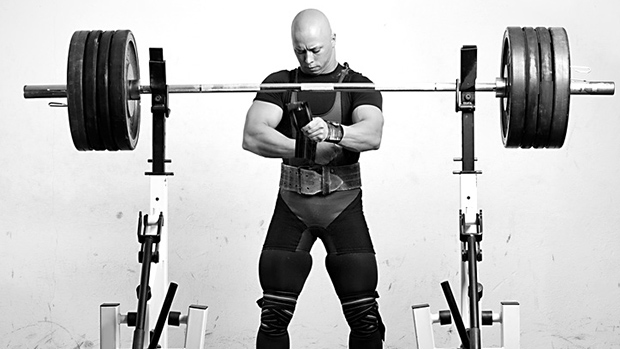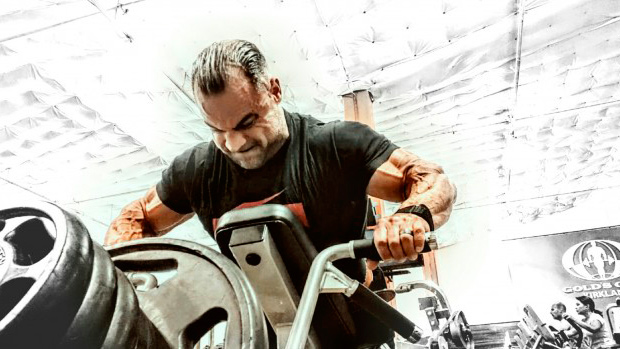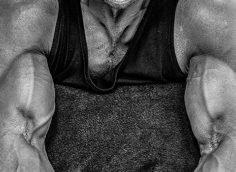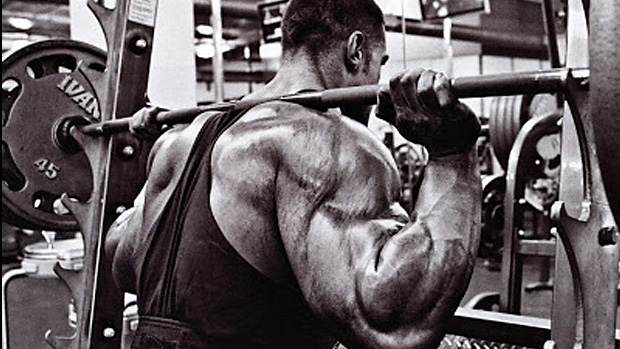It's Not Just About "Training Legs"
Pain. Suffering. Lactic-acid paralysis.
Some workouts not only tax your muscles, they also challenge your mental toughness, testing your courage and even your character.
High-rep leg specialization is a badge of hardcore bodybuilding and will shred you down to the essence of who you are.
The dramatic training results of many old-school bodybuilding stars such as Steve Reeves, Larry Scott, Reg Park (who did up to 50 reps per set), John Grimek, and many others, is undeniable proof of the benefits of high reps.
My personal best squats over the years were 305 x 75, 405 x 27, and 455 x 15 at a bodyweight of 212 pounds or under. Those were with a barbell, unracked once, repped deep enough, and then re-racked only after the reps were completed.
This is a rugged, painful routine, just as it should be. You want to drive your legs to the point where they can't help but respond by growing.
If you can walk normally immediately after this workout, you're not working hard enough.
This type of leg specialization program has allowed bodybuilders to add inches to their legs, but equally impressive is the effect it's had on the rest of their bodies. Leg specialization has a tremendous anabolic effect on other muscle groups.
In many cases, bodybuilders have experienced a solid 1-inch gain on their upper arms, usually accompanied by a 10-pound muscle mass gain, as long as their eating was up to par. But then, if it wasn't, they wouldn't get past week two.
High reps improve cardiovascular function, respiratory efficiency, muscular bulk and definition, articulation and mobility of joints, coordination, and endurance.
With high-rep back squats, your mind has to play a big part too, because they're just too damn hard to do without full commitment.

Plan your routine to include the following leg workouts at the beginning of the training week and/or immediately following a rest day when your energy is at its highest.
Cycle 1 (4 Weeks)
Perform this workout twice a week on non-consecutive training days.
- Set 1: First warm-up. 30 very easy reps, full range of motion, followed by a 60-90 second rest.
- Set 2: Second warm-up. 20 easy reps, full range of motion, followed by a brief rest.
- Set 3, 4, and 5: Three full range of motion "growth zone" sets of 15 reps each, resting 2-3 minutes between each set.
- Set 6: One all-out 30-rep "pump" set.
Notes
- The warm-up sets are performed with a poundage that could be done for an additional 10 reps before fatigue, i.e., weights you could do for 40 reps and 30 reps, respectively.
- The "growth zone" sets refer to the maximum amount of poundage you can do correctly for 15 reps. No more and no less. Try to use the same weight on each set, but you may have to adjust the amount used when moving from one set to the next due to fatigue.
- By the end of the 30-rep "death set" you should have rivers of sweat cascading down your face and be breathing like a person having an asthma attack.
Cycle 2 (4 Weeks)
During the next four weeks, everything's the same, except that you'll be doing an additional two growth zone sets of 15 reps. Perform the workout twice each week.
- Set 1: 30 reps
- Set 2: 20 reps
- Set 3: 15 reps
- Set 4: 15 reps
- Set 5: 15 reps
- Set 6: 15 reps
- Set 7: 15 reps
- Set 8: 30 reps
Rest 60-90 seconds after the first two sets. Rest 2-3 minutes after the 15 rep work sets and several days after the 30 rep set!
Cycle 3 (4 Weeks)
During the final cycle, everything's mostly the same, still repeating this workout twice per week, except now you'll be doing an additional two growth zone sets. And no, I'm not kidding.
- Set 1: 30 reps
- Set 2: 20 reps
- Set 3: 15 reps
- Set 4: 15 reps
- Set 5: 15 reps
- Set 6: 15 reps
- Set 7: 15 reps
- Set 8: 15 reps
- Set 9: 15 reps
- Set 10: 30 reps
Will this work? Yes, and it has for decades. But it'll only work if you do.
While I've had success using this squat method with hundreds of bodybuilders, I can understand that some would prefer to use the leg press.
With the leg press, there's no oppressive weight on the shoulders, no balance or coordination problems, and it's a mechanically-controlled movement where you can apply the developmental stress exactly where you want it.
I'll begrudgingly agree to those arguments.
If using a leg press instead of a barbell convinces you to attack high-rep leg work, have at it.




